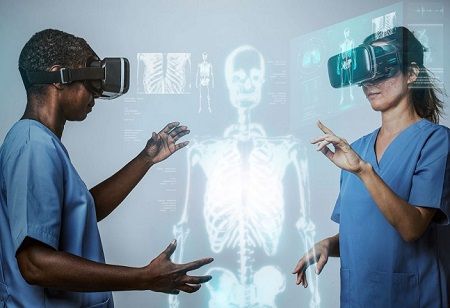-
Virtual Reality (VR) has impacted several fields among them nursing education, due to the features that it holds in its capacity to deliver realistic and interactive learning environments. In nursing education, VR boons students with exclusive possibilities of rehearsing clinical competencies in as real-life-like simulated settings as possible. Not only does this technology improve learning outcomes but also the way that patients are treated due to the students’ ability to interact with virtual patient situations. This article explores the benefits of using VR in nursing education, how it has been integrated into curricula to enhance skill learning, its effects on patients via virtual simulations, the challenges of implementing VR in learning institutions, and the bright future of this innovative tool in education. In this respect, the role of VR in the future advancement of nursing professionals is essential in expanding the knowledge of health care.
Advantages of Virtual Reality in Nursing Student Education
The advantages of using VR in nursing education include the following: Because the students are taken through real-life experiences in the clinical practice, they can practice in real clinical scenarios without having to go through actual clinical environments. It allows the students to practice and even make mistakes within a controlled environment that is safe for patients. This helps to build up their confidence and competence before dealing with real patients. However, VR can present conditions that are hard to come by or complicated that a student may not experience throughout his or her training period. Such exposure helps them to be ready for a wider range of situations when they join the job market. Moreover, VR enhances the learning environment by making the process more interactive than the conventional teaching-learning process, which enhances knowledge retention and understanding.
VR Simulations for Clinical Skills and Procedures
Clinical skills and procedures are well taught through the use of VR simulations. With the help of VR, students can practice such activities as IV line insertion, injections, as well as physical assessment, in conditions that are as close to real life as possible. Such simulations enable the students to get instant feedback and thus be in a position to correct their mistakes as well as improve on their techniques. For instance, a VR program can allow a patient to go through a scenario of cardiac arrest. The student is under pressure to evaluate the situation and resuscitate the patient and give the right drugs. Such scenarios assist the students in developing critical thinking and decision-making skills, which are very essential in emergency situations.
Integration of VR in Nursing Curricula
The application of VR in nursing education requires keen planning with educators, technology experts, and healthcare professionals. It involves purchasing of VR equipment, ensuring that the faculty is conversant with the equipment and developing modules that will address the intended education objectives. Such institutions as the University of Nebraska Medical Center have adopted this approach where they use VR to practice in emergency situations for nursing students. It enhances learning since it offers experiential learning opportunities that are real and practical in addition to formal teaching practices and clinical sessions. Since an increasing number of schools incorporate VR in their curricula, they increase the ability to prepare future nurses for the complex roles and responsibilities in various settings.
Enhancing Patient Care through Virtual Scenarios
The incorporation of Virtual Reality (VR) in nursing education greatly improves patients’ care since it offers practical exposure to real-life situations. Using VR simulations, nursing students build essential clinical competencies, communication skills, and understanding of patients’ conditions. They can rehearse how to give bad news, teach patients about their conditions, and establish rapport in a low-risk, simulated setting. Furthermore, VR enables the training of cultural sensitivity through the use of patients with different cultural backgrounds, thus enhancing the appreciation of diversity among the nurses. Through the use of VR in education, healthcare institutions prepare future nurses to demonstrate the technical competencies and understanding of patients’ needs in various healthcare facilities.
Overcoming Challenges in Implementing VR in Nursing Education
The following are some of the issues that institutions face when adopting VR in nursing education. The relatively high costs of equipment and software programs cut down school budgets and thus restrict VR adoption. Furthermore, the training of faculty is vital so that educators can be well-equipped and prepared to use and incorporate VR into their teaching. Another challenge is the need to maintain the validity and appropriateness of virtual reality simulations in clinical practice, and this involves engaging healthcare professionals and research. Still, these challenges can be overcome and the result can be significant improvements in students’ interest, clinical skills, and readiness to address various patient situations. By implementing the right strategies and investing in VR, institutions can effectively incorporate VR in the enhancement of nursing courses and the improvement of patients’ quality of care.
Conclusion: The future of VR as a tool in nursing education is bright due to the continued innovations in technology that make the application of VR better and easier. Technological advancements such as haptic feedback and Artificial intelligence are expected to enhance VR simulations to be real and personalized to fit the learner. This Article will seek to discuss the advantages of implementing VR in the training of future nurses and will demonstrate that, by offering authentic training simulations, the technology can enhance the student’s clinical competencies and self-confidence. While there are numerous challenges to incorporating VR in nursing education. These developments help to maintain nursing education at the cutting edge to equip healthcare professionals with the ability to deliver quality patient care in complex and dynamic health systems.
🍪 Do you like Cookies?
We use cookies to ensure you get the best experience on our website. Read more...

